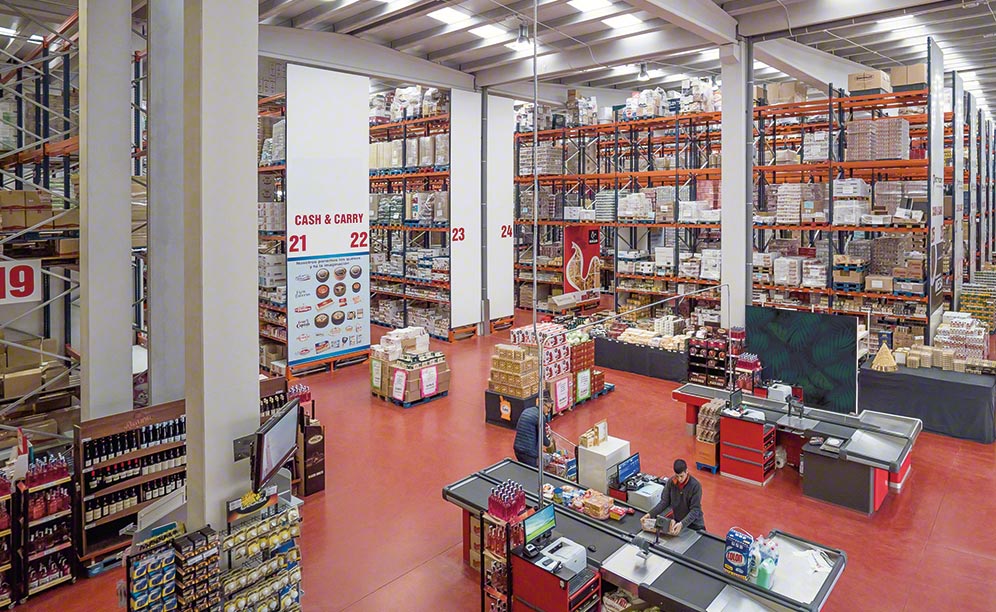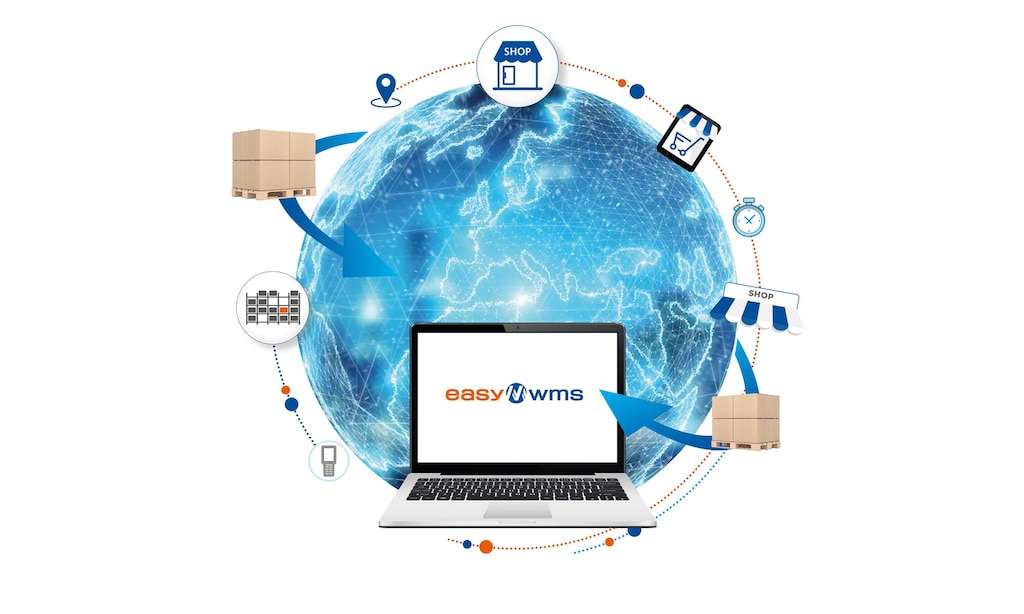Although online sales continue to grow by leaps and bounds, customers are still frequenting physical shops to purchase some of the products they need. To foster this mixed reality between the online and offline worlds, Mecalux has launched the Store Fulfillment module. This extension of the Easy WMS warehouse management system enables businesses to monitor the status of the stock in their warehouses and bricks-and-mortar shops in real time. This system also syncs procurement, picking, replenishment and returns operations.
The expansion of omnichannel logistics is completely transforming the way in which facilities and physical shops are run, blurring the lines that have traditionally separated the two.

Shops, more than just points of sale, have turned into local warehouses, where customers can do their shopping as well as pick up online orders. Warehouses have also taken on new roles: besides dispatching products to online customers, they often supply shops and handle returns, making them cash-and-carry establishments, where customers buy their products in bulk.
One solution for coping with the rising number of orders is to integrate management of the stock between the warehouse and the network of shops
Against this backdrop, it is clear that logistics management in companies is becoming more and more complex. One solution for coping with the rising number of orders and products is to integrate management of the stock between the warehouse and the network of shops.
How can they be integrated? Easy WMS from Mecalux has the answer in the form of the Store Fulfillment module. This software controls inventory in each facility and at each point of sale. The system optimises replenishment and transfers of items between shops and warehouses efficiently and without error.

Store Fulfillment adapts to any shop and warehouse
- Warehouse with counter. Customers go to the counter in the facility to request the products they need, and operators are charged with retrieving the items. Once the sale is made, the system updates the inventory automatically.
- Shop integrated in warehouse. This consists of a shop located in the facility itself. The shop has its own stock, which is replenished with goods from the warehouse.
- Direct sales warehouse. Customers go to the warehouse to take the merchandise they need directly from the shelves and then head towards the counter to pay.
- Central warehouse and independent shops. The goods in the shops located at different geographical points are replenished with the stock on hand in the distribution centre.
The 7 functions of Store Fulfillment from Mecalux for efficient stock management
Store Fulfillment achieves efficient management of stock in the warehouse and shops through:
- Integration with point-of-sale (POS) terminals. In the shops, all transactions are made at a POS, that is, a credit card terminal that allows payment by credit or debit card and prints a receipt. Store Fulfillment is integrated with these terminals in such a way that, when a sale is finalised, the POS informs the WMS, which modifies the stock available in the shop and the facility.
- Returns management. Reverse logistics is a major headache for any company. When a customer returns a product purchased previously, the POS informs Store Fulfillment for it to update the stock available in the shop and the warehouse. With this information, the company can quickly decide what to do with each product based on its returns policy. For example, the items could be sent back to the facility for repair or returned to the supplier.
- Goods shipments from the shop to the warehouse. Store Fulfillment also controls products returned to the warehouse by the shops (items replaced due to the launch of a new collection, for instance). Obviously, if the shop is physically integrated into the warehouse, this movement is much quicker. On the other hand, if the shop is located further away, Store Fulfillment manages the shipment (usually with lorries). To do this, the system generates a label for each product to help warehouse operators identify each item received and know which shop it came from.
- Shop stock control. Easy WMS monitors all the goods on hand in the facility in real time (entries, exits, movements in the warehouse itself, order picking, etc.). With Store Fulfillment, this functionality is enhanced, and the WMS also knows which goods are available in each shop and the nature of product turnover in the shops.
- Shop stock counts. Shop workers can take inventory in their establishments. This process consists of counting the products in the shop, one by one, to know what goods are available and contrast the actual stock with that recorded in the book inventory. One particular feature of Store Fulfillment is that stocktaking can be paused (to attend to a customer, for example) and continued later to avoid interrupting other tasks.
- Shop replenishment. Minimum stock levels are configured for the shops to ensure that they always have the goods they need to serve customers. With Store Fulfillment, communication between the warehouse and the shops is seamless. As a result, adequate stock levels are maintained. On the one hand, the shops can request goods whenever required. On the other, Store Fulfillment reviews the stock in the shops in real time and plans replenishment taking into account the frequency criteria established (daily, weekly, etc.).
Operators can also consult shipment status. Via the computer screen, they have a detailed view of which products each shop has received, which are in transit and how many lines of stock could not be dispatched from the central warehouse. - Automatic report creation. Thanks to the integration of Store Fulfillment with the POS, this software monitors products sold as well as returns. The system generates reports automatically on the increases, decreases and turnover of stock in the shop and warehouses.
The Store Fulfillment module optimises goods shipments from distribution centres to shops, as well as returns
System for boosting omnichannel business productivity
The integration of stock between bricks-and-mortar shops and the warehouse is one of the priorities of the omnichannel paradigm.
With increasingly frenetic goods movements in facilities (shipments to shops, to other warehouses or directly to customers), it is vital to accurately control the products to prevent mistakes and delays.
The Store Fulfillment software application from Mecalux provides total visibility of stock in real time. Thanks to this module, companies know the stock they have on hand in their shops and warehouses and can organise replenishment when the time is right. Store Fulfillment is one of Mecalux’s solutions for raising the productivity of businesses with an omnichannel strategy, in addition to the WMS for Ecommerce, Multi Carrier Shipping Software, and Marketplaces & Ecommerce Platforms Integration modules.
Benefits of Store Fulfillment
- Inventory always up-to-date in warehouse and shops.
- Elimination of stockouts in shops.
- Synchronisation of operations between the warehouse and shops.
- Control over product transfers between shops and the warehouse.
- Efficient returns management.
- Monitoring of consumption in shops according to turnover.
- Turnover tracking of items in the shops.
- End-to-end visibility of distribution in real time.
FAQs about Store Fulfillment |
|---|
|
Which companies can benefit from this module? Those with a distribution centre with different points of sale and that need a single tool to manage all the products. |
|
In which shops or warehouses can it be installed? In any of the following types:
|
|
What functions does Store Fulfillment perform? The software knows the amount of stock available at the points of sale and organises the automatic replenishment of the goods. Each shop can determine a minimum stock level for each of its products; the minute that level is reached, Store Fulfillment automatically notifies the distribution centre so that it can send the required goods at once. This module also controls product transfers between shops and reverse logistics, that is, shipments of goods from the shop to the distribution centre. |
|
How is this module installed? The implementation of Store Fulfillment is quick and easy: the POS terminal merely needs to be integrated with Easy WMS and with the ERP (enterprise resource planning) system. Thus, when the POS terminal records a transaction, it informs the ERP system so that it can keep track of sales. It also notifies Easy WMS to update the quantity of stock available in the shop and the warehouse. |
|
What advantages does this solution have? Store Fulfillment can help any company to manage all its stock, both in the distribution centre and at the points of sale. By having such accurate information on the goods, the business can automatically organise replenishment tasks and avoid mistakes in product transfers between shops as well as between shops and the distribution centre. |
|
Which operators can access Store Fulfillment information? Operator access to both Easy WMS and Store Fulfillment can be configured individually. All stock information can be accessed from the warehouse, while each shop has data only on the stock available in the establishment itself. |
